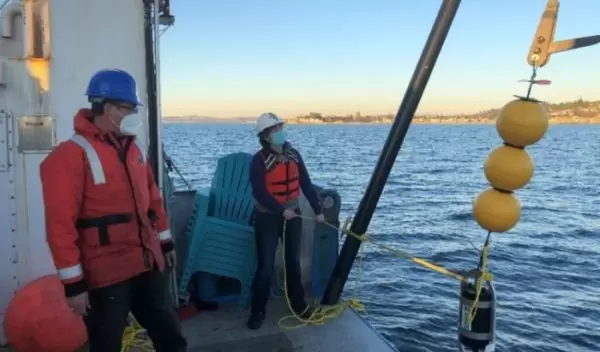
Bubbles of methane rising from seafloor in Puget Sound
The release of methane, a powerful greenhouse gas responsible for almost a quarter of global warming, is being studied around the world, from Arctic wetlands to livestock feedlots. A University of Washington team has discovered a source much closer to home: 349 plumes of methane gas bubbling up from the seafloor in Puget Sound.
The columns of bubbles are especially pronounced off Alki Point in West Seattle and near the ferry terminal in Kingston, Washington, according to a study in Geochemistry, Geophysics, Geosystems. The research is supported by the U.S. National Science Foundation.
"There are methane plumes all over Puget Sound," said lead author Paul Johnson. "Single plumes are all over the place, but the big clusters of plumes are at Kingston and at Alki Point."
The bubbles in Puget Sound were discovered by surprise when the research vessel Thomas G. Thompson kept its sonar beams turned on as it returned to home port. The underwater images created by the soundwaves showed distinct bubble plumes as the vessel rounded the Kingston ferry terminal.
Since then, the team has analyzed sonar data collected during 18 cruises on the research vessel Rachel Carson. Methane plumes were seen from Hood Canal to offshore of Everett to south of the Tacoma Narrows. At Alki, the bubbles rise 200 meters (656 feet), about the height of the Space Needle, to reach the ocean's surface.
"Off Alki, every 3 feet or so there's a crisp, sharp hole in the seafloor that's 3 to 5 inches in diameter," Johnson said. "There are holes all over the place, but there aren't bubbles or fluid coming out of all of them. There's occasionally a burst of bubbles, and then another one 50 feet away that has a new burst of bubbles."
The study is a step toward exploring the release of methane from estuaries, or places where saltwater and freshwater meet. Though only a small amount of natural methane is released, understanding how the greenhouse gas cycles through ecosystems becomes increasingly important with climate change.
"The abundance of methane bubble plumes in Puget Sound is unexpected," said Debbie Smith, a program director in NSF's Division of Ocean Sciences. "Determining the origin of that methane is an exciting next step."


